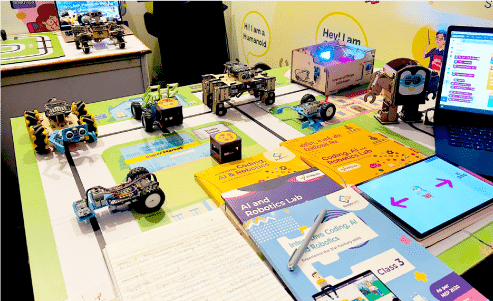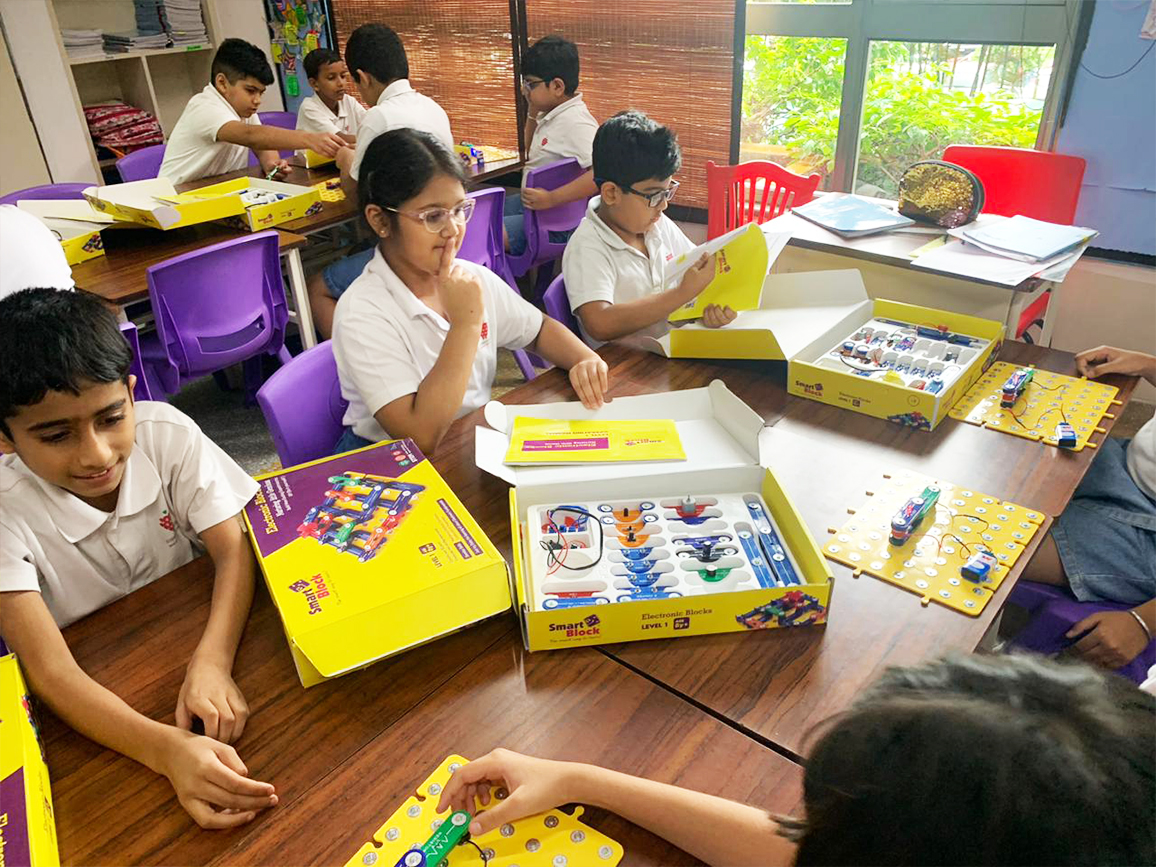Imagine entering a futuristic STEM lab at a leading educational center in Qatar. Instead of the usual whiteboard and traditional lectures, you see an intelligent robot teachers, programmed to guide, motivate, and assist students in mastering complex science and technology concepts. This is no longer a scene from a sci-fi movie it is becoming a reality in Qatar’s education system. The use of robot teachers in STEM labs is revolutionising the way students learn and interact with technology, blending innovation with personalised education like never before.
The integration of robots into education is not merely about replacing human teachers. It is about enhancing learning experiences, sparking curiosity, and preparing students for a world driven by technology and innovation. These robotic educators are transforming classrooms into hubs of creativity, collaboration, and futuristic exploration, aligning perfectly with Qatar’s vision for educational excellence.
Benefits of Robot Teachers in Enhancing STEM Education
Robot teachers bring an unmatched level of consistency and adaptability to the learning process. They deliver lessons with precise accuracy, ensuring students grasp every concept, from the basics of coding to the intricacies of artificial intelligence. Unlike traditional teaching methods, robots can repeat lessons as many times as needed, giving students unlimited chances to master a topic without feeling rushed or judged.
In STEM education, where hands-on experiments and problem-solving are critical, robot teachers use interactive simulations, virtual labs, and real-time data analysis to make abstract theories tangible. This practical approach helps students better understand challenging subjects like mathematics, physics, and engineering. It also nurtures problem-solving skills, creativity, and logical thinking key traits for success in the modern world.
Another significant benefit is the elimination of bias or fatigue. Robots maintain the same level of enthusiasm and accuracy throughout the day, ensuring every student receives equal attention. This creates a fair and motivating learning environment where students feel confident to ask questions and explore deeper knowledge.
Transforming Student Engagement and Motivation
The presence of robot teachers creates an exciting atmosphere that students eagerly embrace. Their interactive teaching style, combined with modern technologies like augmented reality, gamified learning, and instant feedback, keeps students engaged from start to finish. Learning no longer feels like a burden; instead, it becomes a thrilling journey of discovery.
Students report that lessons with robot teachers feel more dynamic and less stressful. Robots can adapt to each learner’s pace and interests, tailoring lessons to keep curiosity alive. For instance, a student passionate about robotics can receive extra modules on engineering principles, while another interested in coding can dive deeper into programming exercises. This personalised touch enhances motivation and encourages students to take ownership of their learning.
The novelty of learning from robots also creates a sense of excitement that traditional methods often lack. This enthusiasm often transforms into long-term interest, inspiring students to pursue careers in science, technology, engineering, and mathematics.

Supporting Teachers and Enhancing Collaboration
One of the biggest misconceptions is that robot teachers will replace human educators. In reality, they act as powerful assistants, enabling teachers to focus on areas where human connection is irreplaceable. While robots handle repetitive tasks such as grading quizzes or demonstrating experiments multiple times, human teachers can dedicate more time to mentoring, emotional support, and encouraging critical thinking.
This collaboration between human and robot teachers results in an enhanced learning experience. Teachers gain new tools to monitor student progress, analyse learning patterns, and customise lesson plans more effectively. Instead of feeling replaced, educators feel empowered, as robots reduce their workload and allow them to focus on creative and strategic aspects of teaching.
Inclusivity and Individualized Learning
Qatar’s classrooms are diverse, with students from different cultural, linguistic, and educational backgrounds. Robot teachers address this diversity by offering multilingual support and adapting lessons to various learning styles. Whether a student learns best through visuals, audio, or hands-on practice, the robot can modify its approach to fit individual preferences.
For students with learning difficulties or disabilities, robots can provide personalised assistance, ensuring they progress at their own pace without feeling left behind. This inclusive environment ensures that every learner, regardless of their challenges, receives quality education tailored to their needs.
By offering such personalized experiences, robot teachers contribute to closing learning gaps and promoting equal opportunities for all students.
Preparing Students for a Tech Driven Future
The integration of robot teachers in Qatar’s STEM labs is more than a modern teaching experiment—it is a direct investment in the future workforce. Students exposed to advanced robotics, artificial intelligence, and automation at an early age develop technological fluency that gives them a competitive edge in higher education and future careers.
Working alongside robots also helps students build confidence in using cutting-edge technology. They learn to code, troubleshoot, and interact with intelligent systems skills highly demanded in the global job market. More importantly, they develop a mindset of innovation, creativity, and adaptability, qualities essential for thriving in a rapidly changing world.
Real World Success Stories from Qatar Educational Centers
The introduction of robot teachers in several educational centres across Qatar has already yielded impressive results. Schools implementing robotic teaching assistants have reported significant improvements in student performance, particularly in subjects such as coding, mathematics, and physics. Attendance rates in STEM labs have increased, and students are showing greater enthusiasm for projects and experiments.
One student shared, “The robot teacher never gets tired of explaining. It encourages me when I get something right, and if I make a mistake, it helps me try again.” Teachers also appreciate the support robots provide, allowing them to spend more time on creative lessons and one-on-one mentoring.
These success stories demonstrate how blending technology with education can inspire a new generation of thinkers, problem-solvers, and innovators.
Challenges and Thoughtful Implementation
While the benefits are clear, introducing robot teachers also presents challenges. The initial investment in advanced robotic systems can be costly, and regular maintenance is required to keep them functioning smoothly. Additionally, schools must train staff to integrate robots effectively into the curriculum.
Ethical considerations such as data privacy and ensuring that robots do not replace the human element in education are also important. To address these concerns, Qatar’s educational centres are adopting a balanced approach, using robots as tools to enhance not replace human teaching.
Pilot programs and phased implementations ensure that robots are introduced gradually, giving educators time to adapt and refine the system. This careful approach allows the technology to evolve naturally within the educational environment.

Ensuring Emotional Connection and Human Touch
One of the biggest criticisms of robot teachers is their lack of emotional intelligence. While robots can simulate certain interactions, they cannot fully replicate the empathy, understanding, and emotional support that human teachers provide. This is why Qatar’s approach focuses on a hybrid model where robots handle structured lessons, while human educators build emotional connections with students.
This balance ensures that while technology enhances learning, the human aspect remains at the heart of education. Students still have mentors who inspire, motivate, and understand their personal challenges, ensuring that education remains a deeply human experience.
Vision for the Future Scaling and Innovation
Looking ahead, Qatar is set to expand the use of robot teachers beyond STEM labs. Plans include integrating them into coding boot camps, robotics clubs, and advanced science workshops, creating a comprehensive technology-driven learning ecosystem. As AI capabilities evolve, robot teachers will become even more interactive, intuitive, and personalised.
Future advancements may also incorporate virtual reality, augmented reality, and holographic teaching assistants, taking learning experiences to an entirely new level. These innovations will allow students to collaborate with peers worldwide, participate in virtual experiments, and experience education without boundaries.
Conclusion
The use of robot teachers in Qatar’s STEM labs is a bold step toward redefining education. Far from being mere gadgets, these robots are powerful allies that enhance learning, boost motivation, and prepare students for a future where technology is central to every aspect of life. By combining the precision of robots with the empathy of human teachers, Qatar is creating an educational model that is both innovative and human-centred.
With thoughtful implementation, continuous innovation, and a commitment to inclusive, robot teachers will continue to inspire generations of learners. They are not just teaching science and technology they are shaping future innovators who will lead the world with confidence, creativity, and intelligence.
Do follow Gulf Magazine on Instagram.
Also Read – Energy Grid Modernisation Qatar Powers a Sustainable Future



